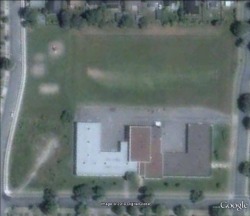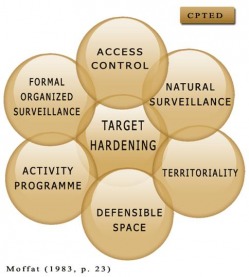SITE SELECTION

The original Playground Committee had previously vetted locations during their process. The loss of the play structure has demanded the examination of site candidate locations that for a variety of reasons, may not be sites of first choice.
The soccer field is HRM property (not HRSB) and would require grade alterations at significant cost and disruption to field programming.
The Leeds site was determined to be too far away from the P-2 entrance (travel time) and also presented supervisory challenges. Ideally the two play structures would be located near one another to enable supervision for families with multiple children of varying ages and abilities.
The outdoor classroom has a demonstrated track record of a (relatively) damage-free status. Evaluating the sites with the CPTED filter as the guiding principle, the Committee collaborated to find solutions to the remaining site challenges. By using a Consensus Approach decisions were agreed upon that sometimes meant not always getting what each member wanted but rather a compromise that we all could live with.
The soccer field is HRM property (not HRSB) and would require grade alterations at significant cost and disruption to field programming.
The Leeds site was determined to be too far away from the P-2 entrance (travel time) and also presented supervisory challenges. Ideally the two play structures would be located near one another to enable supervision for families with multiple children of varying ages and abilities.
The outdoor classroom has a demonstrated track record of a (relatively) damage-free status. Evaluating the sites with the CPTED filter as the guiding principle, the Committee collaborated to find solutions to the remaining site challenges. By using a Consensus Approach decisions were agreed upon that sometimes meant not always getting what each member wanted but rather a compromise that we all could live with.

Crime Prevention Through Environmental Design is:
*a pro-active crime prevention strategy utilized by planners, architects, police services, security professionals and everyday users of space.
*the proper design and effective use of the built environment can lead to a reduction in the incidence and fear of crime and improve the quality of life.
*emphasis is placed on the physical environment, productive use of space, and behaviour of people to create environments that are absent of environmental cues that cause opportunities for crime to occur.
*CPTED is common sense.
It was Jane Jacobs’ idea in the book “Death and Life of Great American Cities” that healthy cities could function and be safe starting from the small scale to the large scale: the sidewalk on the street of a block in a neighbourhood within the larger city and the social interactions that are affected by the physical layout. Her idea of “eyes on the street” is a key principle of CPTED. Oscar Newman, an architect, published “Defensible Space: Crime Prevention Through Urban Design” in 1972. Newman analysed public housing in New York and proposed environmental design concepts to prevent crime: surveillance, territoriality, defensibility, maintenance and milieu.
Applying CPTED starts by asking:
*What is the designated purpose of the space
*how is the space defined and
*how well does the physical design support the intended function
Only then, can effective design or problem solving begin.
CPTED involves four basic principles:
* Natural Surveillance - Is the placement of physical features and/or activities, and people that maximizes natural visibility or observation. The selected site features open site lines into the area for passersby (pedestrians and vehicles), residents and police patrol. Equipment components have been carefully selected to reduce hiding places.
- Visibility
- Neighbourhood Guardians
- Pedestrians
- Vehicle Traffic
- Police Patrol
*Territorial Reinforcement - Defines clear borders of controlled space from public to semi-private to private, so that users of an area develop a sense of proprietorship over it. •School admin. Flexible programming •Outdoor classroom use •Site preparation The message sent is “this space is owned by the kids of St. Stephen’s”.
- Natural Surveillance
- Neighbourhood Guardians
- HRSB Property
- School Administration
- Timely Installation
* Access Control - Deters access to a target and creates a perception of risk to the offender. Defining the formal entryways into the site limits unauthorized access and egress. The site will feature vinyl coated chain link fencing and an interactive panel wall defining the play area with two un-gated entrances provided from the Grade 2 building entrance and the driveway at the school building wall.
- Fencing
- Two Entry Points
- Limited Escape Routes
* Target Hardening is the traditional approach to crime prevention and security; make it more difficult for unwanted activity to occur. Efforts to deter vandalism include: •Security lighting •HRSB policy “no loitering” signage •Video cameras •Access control via fencing/play panels These measures are both proactive and reactive.
- Security Lighting
- "No Loitering" Signage
- Video Surveillance
*a pro-active crime prevention strategy utilized by planners, architects, police services, security professionals and everyday users of space.
*the proper design and effective use of the built environment can lead to a reduction in the incidence and fear of crime and improve the quality of life.
*emphasis is placed on the physical environment, productive use of space, and behaviour of people to create environments that are absent of environmental cues that cause opportunities for crime to occur.
*CPTED is common sense.
It was Jane Jacobs’ idea in the book “Death and Life of Great American Cities” that healthy cities could function and be safe starting from the small scale to the large scale: the sidewalk on the street of a block in a neighbourhood within the larger city and the social interactions that are affected by the physical layout. Her idea of “eyes on the street” is a key principle of CPTED. Oscar Newman, an architect, published “Defensible Space: Crime Prevention Through Urban Design” in 1972. Newman analysed public housing in New York and proposed environmental design concepts to prevent crime: surveillance, territoriality, defensibility, maintenance and milieu.
Applying CPTED starts by asking:
*What is the designated purpose of the space
*how is the space defined and
*how well does the physical design support the intended function
Only then, can effective design or problem solving begin.
CPTED involves four basic principles:
* Natural Surveillance - Is the placement of physical features and/or activities, and people that maximizes natural visibility or observation. The selected site features open site lines into the area for passersby (pedestrians and vehicles), residents and police patrol. Equipment components have been carefully selected to reduce hiding places.
- Visibility
- Neighbourhood Guardians
- Pedestrians
- Vehicle Traffic
- Police Patrol
*Territorial Reinforcement - Defines clear borders of controlled space from public to semi-private to private, so that users of an area develop a sense of proprietorship over it. •School admin. Flexible programming •Outdoor classroom use •Site preparation The message sent is “this space is owned by the kids of St. Stephen’s”.
- Natural Surveillance
- Neighbourhood Guardians
- HRSB Property
- School Administration
- Timely Installation
* Access Control - Deters access to a target and creates a perception of risk to the offender. Defining the formal entryways into the site limits unauthorized access and egress. The site will feature vinyl coated chain link fencing and an interactive panel wall defining the play area with two un-gated entrances provided from the Grade 2 building entrance and the driveway at the school building wall.
- Fencing
- Two Entry Points
- Limited Escape Routes
* Target Hardening is the traditional approach to crime prevention and security; make it more difficult for unwanted activity to occur. Efforts to deter vandalism include: •Security lighting •HRSB policy “no loitering” signage •Video cameras •Access control via fencing/play panels These measures are both proactive and reactive.
- Security Lighting
- "No Loitering" Signage
- Video Surveillance
